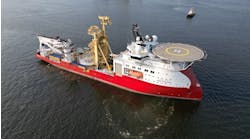Kevin C. Peterson
Chief Operating Officer
Ceanic Coproration
Intervention planning
Intervention is a term often associated with remotely operated vehicles ( ROVs), however, it applies equally to work performed by divers and atmospheric diving suits (ADS). Intervention services, whether provided by man or machine, often becomes the critical path and determines the outcome of even the largest of projects.To ensure that the outcome is favorable, up front engineering and planning is an absolute requirement. The ultimate success of the project, as indicated by the financial budget and schedule, will be a direct result of the level and quality of this pre-job planning effort.
The investment into pre-job planning and engineering to make the subsea equipment intervention ready, or to modify the installation procedure to facilitate the specific type of intervention planned, pay dividends in the form of reduced project costs. In the scope of a typical project, the cost for this pre-job engineering and planning is generally a very small percentage of the overall budget, but can have a significant impact on the final cost of the project.
As the industry evolved and the water depths increased, various intervention techniques and technologies have been developed to address these new frontiers. Looking back a few years, the term diver friendly was often applied to those subsea tools and systems which had been modified to facilitate diver intervention. Gradually, the concept of designing subsea equipment that a diver could work on with ease became more common place.
As project water depths passed the efficient diving range, ROVs were developed. As work ROVs became available, reliable, and more capable, engineers began to develop subsea equipment that was ROV friendly. The term diverless was initially used to describe these ROV friendly systems. "Remote intervention" was applied to the combination of the work ROV, the dedicated work package/tooling and the subsea equipment that was specially designed to accept this form of intervention.
Somewhere in between diving and ROV developments, the ADS capability was introduced and refined. The WASP and JIM suits were planned into projects, then with the evolution and improvement of hard suit technology to 2000 fsw, the gap between divers and ROVs has been effectively filled. Once again, a specific level of up front engineering and planning is required to facilitate ADS intervention. The hard suit puts a human at the work site, but without 100% of the capability of a diver. However, the suit provides lighting, video, sonar, and thrusters, similar to those of an ROV.
Although no two projects are exactly alike, there are specific points that should be considered when planning the intervention portion of a project. In reviewing the scope of the project, there are several very basic points to review to identify the safest and most productive method of intervention. For example:
- Water depth: This is the first gate in the process a picking the most appropriate intervention technique. If the water depth is within diving range, then you have three choices. If greater than diving range, but still within ADS range, you have two. If you're in 2500 fsw, then you only have one way to go.
- Safety: After determining the intervention technique is applicable to the task based on depth, the next consideration must be safety. Safety must always be the first consideration when deciding which intervention system or technique is to be deployed. The issue is a very serious topic, which deserves a great deal of emphasis in pre-job planning, especially in the case of manned intervention.
- Cost effectiveness: After considering all aspects of safety, the focus then turns to picking the technique most cost effective within the given parameters of the project. Location, available marine equipment, decompression times logistics, water depths, complexity of tasks, and many other factors all contribute to deciding which form of intervention is going to be most cost effective for a specific project.
- Divers: The number one consideration when planning a diving project is always safety. Pre-job planning should always focus on ensuring the work site and subsea tasks are as safe as possible. Then the project and tasks must consider the basic strengths and weaknesses of a diver, including; ten fingers, two eyes and a brain on site; ability to improvise at the work site; limited bottom time and decompression requirements; limited strength and onboard power; and limited excursion radius, subject to length of umbilical.
- ADS: Once again, safety is a key issue. The ADS, such as the hard suit, puts a person at the work site, but eliminates decompression requirements. The hard suits also bring to the work site many ROV features, including lights, video cameras, sonar, and tools. Other considerations include: two eyes and a brain on site, but two manipulators instead of ten fingers; longer bottom time, with no decompression requirements; limited strength, but some onboard power; thrusters providing "flying" capability similar to ROVs; and limited excursion radius, subject to the length of umbilical.
- ROV: Even though the human is out of the water, safety issues are still important, especially considering the new work ROV systems, that weigh several tons and operate at up to 3000 vac. ROV's can carry more power, more tooling, stay down longer and deploy a wide variety of technology to the work site. Up front engineering becomes more critical, as the ability to improvise diminishes with an ROV, compared to a diver or hard suit. Basic issues to consider are: remote manipulator, instead of arms/hands, so limited dexterity and feel; cameras provide limited depth perception; larger size (in most cases) limiting access to some locations; longer bottom times, so scheduling is less critical; higher power (hydraulic and electric) available at the work site; and heavy payloads can be deployed and positioned.
This page reflects viewpoints on the political, economic, cultural, technological, and environmental issues that will shape the future of our industry. Offshore Magazine invites you to share your thoughts. Send your manuscript to Beyond the Horizon, Offshore Magazine, Box 1941, Houston, TX 77251 USA. Manuscripts will not be returned.
Copyright 1998 Oil & Gas Journal. All Rights Reserved.


